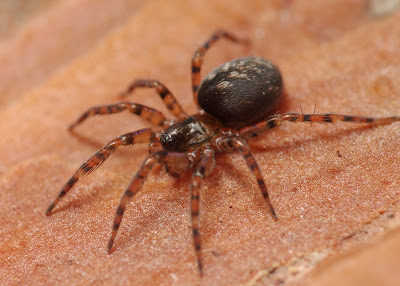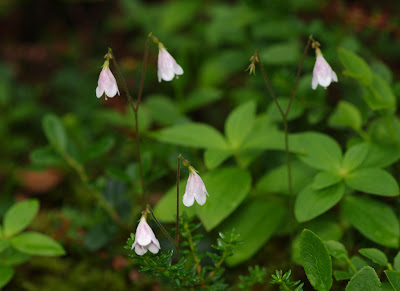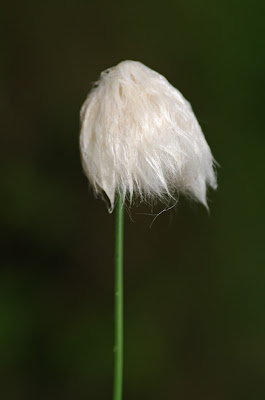Ending the series of posts about Norway, this time I write about some areas around the city of Kirkenes. We visited several interesting habitats here: fjords, birch woods, lakes and barren hilltops.
A Norvégiáról szóló beszámolósorozat zárásaként ezúttal a Kirkenes városa közelében meglátogatott területekről írok. Több érdekes élőhelyet felkerestünk itt: fjordokat, nyíreseket, tavakat és kopár magaslatokat.
Location/Helyszín: Around Kirkenes/Kirkenes körül. Date/Dátum: 29.07.2011.
Between the town and the small airport, there is an area with smaller hills (there are several old WWII bunkers here) and birch forests. Around one of the bunkers, we stopped for some spider-collecting. Not only did we find several different species, but also some interesting plants.
A városka és a kis reptér között egy alacsonyabb dombokkal tarkított vidék fekszik (több második világháborús bunker is található erre), sok nyírerdővel. Az egyik bunker közelében megálltunk egy kicsit pókokat gyűjteni. Nemcsak több különböző fajt találtunk, de érdekes növényeket is.
Cryphoeca sylvicola. This spider is a taxonomic aenigma: it has been assigned to several different families. Nowadays it is regarded as a member of the family Hahniidae.
Cryphoeca sylvicola. Ez a pók egy igazi taxonómiai enigma: számos különböző családba besorolták már, jelenleg a Hahniidae család tagjának tartják.
A female Leptorhoptrum robustum. This ground-dwelling linyphiid spider is bigger than most of its relatives, with a body size of about 4 mms.
Egy Leptorhoptrum robustum nőstény. Ez a talajlakó vitorláspók a legtöbb rokonánál jóval nagyobb, mintegy 4 mm hosszú.
At this place we found the insectivore plant Common Butterwort (Pinguicula vulgaris).
Megtaláltuk itt a rovaremésztő lápi hízókát is (Pinguicula vulgaris).
A photo from the twin-flower mentioned earlier:
Egy kép a korábban már említett Linné-virágról:
Eriophorum scheuchzeri, the White Cotton Sedge.
Eriophorum scheuchzeri, a Scheuchzer-gyapjúsás.
This small snail was under a stone. This was the only snail specimen we found during the whole week!
Ez az apró csiga egy kő alatt volt. Ez volt az egyetlen csiga, melyet az egész hét során találtunk!
Althogh we had been warned about the mosquitoes swarming in clouds in the nordic regions, we did not see many at all. Only at a few places were they very annoying. Here, near Kirkenes, there were quite many of this species, Ochlerotatus sticticus:
Bár előre figyelmeztettek bennünket az északi régiókban felhőkben rajzó szúnyogokkal kapcsolatban, egyáltalán nem láttunk sokat belőlük. Csak pár hely volt, ahol elég kellemetlenek voltak. Itt, Kirkenes mellett, elég sok akadt ebből a fajból, az Ochlerotatus sticticus-ból.
Later we traveled a few kilometers north of Kirkenes along the fjords, to Jakobsnes. This place is characterised by smaller lakes, birch forests and not tall, yet barren hilltops.
Később elmentünk néhány kilométerrel Kirkenestől északra, végig a fjordok mentén, Jakobsnes-ig. Ezt a területet kis tavak, nyíresek és alacsony, de kopár csúcsok jellemzik.
The ’fjords’ here in Finnmark are geologically false fjords, as they were carved out not by glaciers, but by the glacial ice pack on the sea.
A Finnmarkban látható ’fjordok’ geológiai értelemben hamis fjordok, mert nem gleccserek vájták ki őket, hanem a tengeren kialakult jégkorszaki jégpáncél.
The birch forest around Jakobsnes:
A nyíres Jakobsnes környékén:
In a small bog here I photographed several Common Sundews (Drosera rotundifolia):
Egy kis lápos területen több kereklevelű harmatfüvet fotóztam (Drosera rotundifolia):
Here I found this nice, golden Sphagnum moss species:
Itt találtam ezt a szép, aranyszínű Sphagnum mohát is:
An unripe cloudberry:
Egy éretlen lápi hamvasszeder:
On a lakeside I photographed an orchid, the only one I found in Finnmark. I suppose it may be the Kola-Peninsula Spotted Orchid, but that is regarded as a variety or subspecies of uncleared status of the Heath Spotted Orchid (Dactylorhiza maculata) (see here).
Egy tó partján került elő az egyetlen orchidea, amit Finnmarkban fotóztam. Esetleg a Kola-félszigeti ujjaskosbor lehet, ám ezt leginkább a foltos ujjaskosbor (Dactylorhiza maculata) egyik tisztázatlan értékű variációjának vagy alfajának tekintik (lsd. itt).
The only reptile species in this area is the Viviparous Lizard (Zootoca vivipara). As they do not lay eggs, their population can survive in the harsh conditions of Finnmark.
Az egyetlen hüllő ezen a környéken az elevenszülő gyík (Zootoca vivipara). Minthogy nem kell tojásokat rakniuk, populációjuk képes fennmaradni Finnmark zord körülményei között is.
We went up to a smaller hill. Because of the harsh winds here, most hilltops are barren, only lichens and very small plants grow on these. This means that small mountain tundra regions are formed on these elevations.
Felsétáltunk itt egy alacsonyabb hegyre. A kemény szeleknek köszönhetően a legtöbb csúcs errefelé kopár, csak zuzmók és nagyon apró növények nőnek erre. Tehát kis hegyi tundra jellegű területek alakulnak ki ezeken a kiemelkedéseken.
Crowberry and butterwort were abundant here:
A varjóbogyó és a hízóka gyakori errefelé:
Egy szép, szimmetrikus részegkorpafű-példány (Huperzia selago):
We found very few animals even under stones here. Only a handful of springtails (collembolans) and some tiny spiders. And the most abundant animals were the centipedes. We suppose that the food chain on these mountain tundras are quite extreme: collembolans feed on fungi, while small spiders feed on these. Bigger spiders feed on the smaller ones and on small insects that are blown here by the wind. And finally, centipedes feed on the spiders and each other. So insects, millipeds, woodlice, snails and many other animals are virtually missing from these ecosystems!
Nagyon kevés állatot találtunk errefelé még a kövek alatt is. Csak pár ugróvillást (collembolát) és néhány kis pókot, illetve a leggyakoribb állatok errefelé a százlábúak voltak. Azt feltételezzük, hogy ezeken a hegyi tundrákon meglehetősen szélsőséges tápláléklánc alakult ki: az ugróvillások gombákkal táplálkoznak, az apró pókok pedig ezekkel. A nagyobb pókok a kisebbekkel táplálkoznak, illetve kis rovarokkal, melyeket a szél sodor ide. Végül, a százlábúk a pókokat eszik, illetve egymást. Tehát a rovarok, ezerlábúak, ászkák, csigák és sok más állat is szinte teljesen hiányoznak ezekből az ökoszisztémákból!
The centipeds (Lithobius sp):
A százlábúak (Lithobius sp):
A nice lichen from on rock:
Egy szép zuzmó egy sziklán:
A video about the plants and landscape around Jakobsnes (view in large in YouTube):
Egy videó a Jakobsnes növényeiről és tájairól (megtekinthető nagyban a YouTube-on):
We also stopped at a fjord. The shores of these are always covered by a species of kelp (Fucus vesiculosus). Many flowers grow near the shores and one can also find some spiders.
Megálltunk egy fjordnál is. Ezeknek a partjai mindig tele vannak egy barnamoszatfajjal, a Fucus vesiculosus-szal. Sok virág is nő a partok mellett, és pókokat is lehet találni.
The alga:
A barnamoszat:
A flower, maybe a Yarrow species:
Egy virág, talán egy cickafark-faj:
A Pardosa palustris wolf spider:
Egy Pardosa palustris farkaspók:
This is a big (2.5 mms) Bdellid snout mite, a predator that roams around the pebbles on the shores (Bdella semiscutata).
Ez egy nagy (2,5 mm) Bdellidae atka, egy ragadozó, mely a parti kavicsok között keres prédát magának (Bdella semiscutata).
Finally, I end the report about Norway with a picture of the sun setting over a fjord:
Végül, a Norvégiáról szóló beszámolót egy fjord felett lemenő nap képével zárom:
I would like to express my thanks to our Norwegian friends, Annie Antonsen, Glenn Halvor Morka and Kjetil Åkra, for arranging this expedition and for their invitation! Also, many thanks for the other two friends who took part in this expedition, Arno Grabolle and Martin Lemke for collecting insect specimens for me while we were there!
Szeretném megköszönni az expedíció megszervezését és a meghívást norvég barátainknak, Annie Antonsen-nek, Glenn Halvor Morka-nak és Kjetil Åkra-nak! Valamint sok köszönet a másik két barátnak, akik részt vettek az expedíción, Arno Grabolle-nek és Martin Lemke-nek, hogy gyűjtöttek nekem rovarokat, amíg ott voltunk!
Many-many thanks for everybody who helped in the identification of my photos: Sok-sok köszönet mindenkinek, aki segített a fotóim meghatározásában: Niclas Frizen (Araneae), Thomas Götz (Coleoptera), PeterH (Lagopus), Frank Köhler (Coleoptera), Attila V. Molnár (Plantae), Nikola Rahmé (Coleoptera), Mihály Tóth (Culicidae).
Recommended Literature/Ajánlott irodalom:







































Hello Walter :)
ReplyDeleteAgain, fantastic pictures from Pasvik and the surrounding areas. It seems just like yesterday we were up there in that fantastic nature. We had a fantastic time all of us, and I thank you and the others for making that week very special. It feels very good to have gotten to know you all, and to make friends with common interests :)
Take care :)
Sincerely
Annie